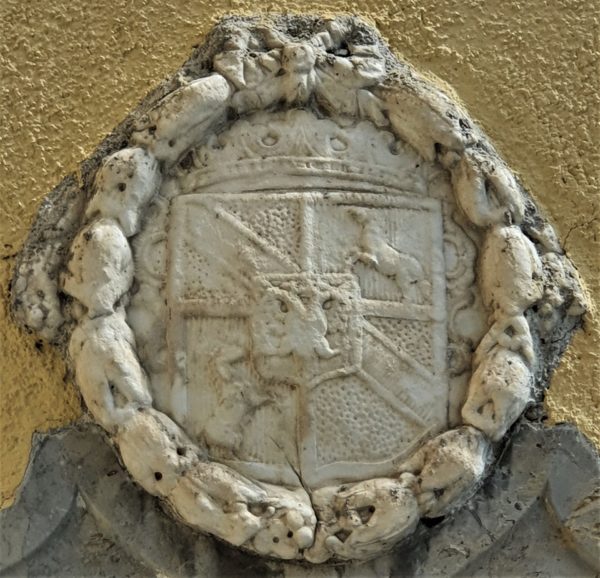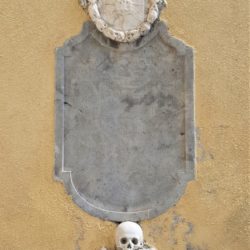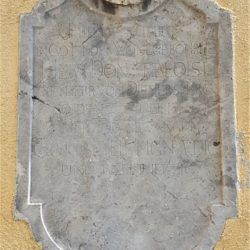
Coat of arms of the Dienersperg family in Vojnik
VOJNIK, ST. BARTHOLOMEW'S CHURCH
Location of the coat of arms: tombstone
The tombstone built into the façade of St. Bartholomew Church in Vojnik belonged to Donat Alois Baron von Dienersperg, who died in 1775. Carved above the inscription is the deceased’s baronial coat of arms featuring a dog (greyhound) and a horse. Although Donat Alois was raised to baronial rank nine years before his death, his coat of arms remained more or less as it was in 1636.
Donat Alois’s predecessors did not bear the surname Dienersperg but merely Diener, and according to some data, they were originally from Regensburg. The first known member of the family in Carniola was Johann Diener, who initially served as the steward of the Bled seigniory (Germ. Veldes) and then as the castellan of Ljubljana Castle. In 1580, Adam Baron von Egkh sold him Bokalce Mansion (Strobelhof), which was passed down through generations of Diener’s descendants for more than three-quarters of the century. Seven years later (in 1587), Archduke Charles elevated him to the rank of nobility. Although the noble diploma from that year has not been preserved, it was referred to several times in his descendants’ legacies and used as a reference in their subsequent noble exploits. Nothing is known about the original Diener coat of arms. Given that Archduke Charles improved it (gebessert) on issuing the diploma, the Dieners must have already had one prior to 1587.
In the generation of Johann’s grandsons Johann Georg and Dietrich, the family attained a new elevation and split into two branches: the Carniolan and the Styrian. In 1631, the brothers were admitted to the Carniolan provincial estates and five years later (in 1636), Emperor Ferdinand II confirmed their noble status with the predicate Dienersperg as well as a new, improved coat of arms. Apart from the dog, the new version also depicted a horse. What they symbolize is not entirely clear; however, their selection might allude to the surname Diener, representing man’s most loyal “servants” (Germ. Diener).
After 1636, the original surname Diener gradually fell out of use, replaced by the predicate Dienersperg (also Dienersberg) as the new family name. Johann Georg founded or, rather, continued the Carniolan Dienersperg branch and Dietrich moved to Styria, assumed the position of the forest master for the Celje Quarter, and established the so-called Styrian branch of the Dienersperg family. Whereas the Carniolan branch died out in the male line in the mid-eighteenth century and in its female line a few years later, the Styrian branch continued until the beginning of the twentieth century.
The deceased from Vojnik, Donat Alois Dienersperg, was Dietrich’s grandson and hence a member of the Styrian branch of the Dienerspergs. He was born about 1701 in Ponikva (Germ. Ponichel) at Šentjur pri Celju (Germ. Sankt Georgen bei Cilli) and inherited the seigniories of Tabor near Vojnik (Germ. Hochenegg) and Ruda near Sevnica (Germ. Ruth bei Lichtenwald). In 1766, he attained a major recognition for him and his family with Maria Theresa granting him baronial rank. The elevation took place at his request, and the baronial diploma merely states general civilian and military merits of his ancestors. The baronial title also entailed a slight change in the family coat of arms.
The baronial title was granted to Donat Alois, his direct descendants as well as his nine nephews from the so-called Ponikva line. They were the sons of his late brother Peter Dominic (died in 1764), the owner of Ponikva Manor.
Donat Alois Baron von Dienersperg died on July 22nd, 1775, and was buried in Vojnik, where his tombstone has been preserved to present day. His family branch ended with the deaths of his granddaughters. The branch of his brother Peter Dominic continued until the twentieth century and became extinct with the death of the last male representative of the family in 1905.
Sources:
Golec, Boris: Vzpon in zaton Dienerspergov. Štajersko potomstvo Janeza Vajkarda Valvasorja v luči svojih genealoško-biografskih in spominskih zapisov (1278–1908). Ptuj: Zgodovinski arhiv na Ptuju, 2017.
Preinfalk, Miha: Plemiške rodbine na Slovenskem, 16. stoletje; 1. del: Od Barbov do Zetschkerjev. Ljubljana: Viharnik, 2016, pp. 55–77.


